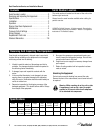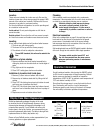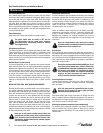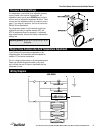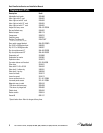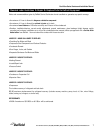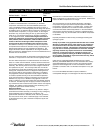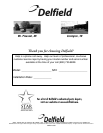
Dual View Series Service and Installation Manual
4
Delfield
™
®
For customer service, call (800) 733-8829, (800) 733-8821, Fax (989) 773-3210, www.delfield.com
Maintenance
Door Gasket Maintenance
Door gaskets require regular cleaning to prevent mold and mildew
build up and also to retain the elasticity of the gasket. Gasket cleaning
can be done with the use of warm soapy water. Avoid full strength
cleaning products on gaskets as this can cause them to become brittle
and crack. Never use sharp tools or knives to scrape or clean the
gasket. Gaskets can be easily replaced and do not require the use of
tools or an authorized service person. The gaskets are “Dart” style and
can be pulled out of the groove in the door and new gaskets can be
“pressed” back into place.
Caster Maintenance
Wipe casters with a damp cloth monthly to prevent corrosion.
The power switch must be turned to OFF and the
unit disconnected from the power source whenever
performing service, maintenance functions or cleaning
the refrigerated area.
Refrigerators and Freezers
The interior and exterior can be cleaned using soap and warm water.
If this isn’t sufficient, try ammonia and water or a nonabrasive liquid
cleaner. When cleaning the exterior, always rub with the “grain” of
the stainless steel to avoid marring the finish. Do not use an abrasive
cleaner because it will scratch the stainless steel and can damage the
breaker strips and gaskets.
Stainless Steel Care and Cleaning
To prevent discoloration or rust on stainless steel several important
steps need to be taken. First, we need to understand the properties of
stainless steel. Stainless steel contains 70- 80% iron, which will rust.
It also contains 12-30% chromium, which forms an invisible passive
film over the steel’s surface, which acts as a shield against corrosion.
As long as the protective layer is intact, the metal is still stainless.
If the film is broken or contaminated, outside elements can begin to
breakdown the steel and begin to form discoloration or rust. Proper
cleaning of stainless steel requires soft cloths or plastic scouring
pads.
NEVER USE STEEL PADS, WIRE BRUSHES OR SCRAPERS!
Cleaning solutions need to be alkaline based or non-chloride cleaners.
Any cleaner containing chlorides will damage the protective film of
the stainless steel. Chlorides are also commonly found in hard water,
salts, and household and industrial cleaners. If cleaners containing
chlorides are used be sure to rinse repeatedly and dry thoroughly.
Routine cleaning of stainless steel can be done with soap and water.
Extreme stains or grease should be cleaned with a non-abrasive
cleaner and plastic scrub pad. Always rub with the grain of the
steel. There are stainless steel cleaners available which can restore
and preserve the finish of the steels protective layer. Early signs of
stainless steel breakdown are small pits and cracks. If this has begun,
clean thoroughly and start to apply stainless steel cleaners in attempt
to restore the passivity of the steel.
Never use an acid based cleaning solution! Many food
products have an acidic content, which can deteriorate the
finish. Be sure to clean the stainless steel surfaces of ALL
food products. Common items include, tomatoes, peppers
and other vegetables.
Cleaning the Condenser Coil
In order to maintain proper refrigeration performance, the condenser
fins must be cleaned of dust, dirt and grease regularly. It is recommended
that this be done at least every three months. If conditions are such
that the condenser is totally blocked in three months, the frequency
of cleaning should be increased. Clean the condenser with a vacuum
cleaner or stiff brush. If extremely dirty, a commercially available
condenser cleaner may be required.
Failure to maintain a clean condenser coil can initially cause high
temperatures and excessive run times. Continuous operation with
a dirty or clogged condenser coil can result in compressor failure.
Neglecting the condenser coil cleaning procedures will void any
warranties associated with the compressor and cost to replace the
compressor.
Never use a high-pressure water wash for this cleaning
procedure as water can damage the electrical components
located near or at the condenser coil.
Doors/Hinges
Over time and with heavy use doors the hinges may become loose. If
this happens tighten the screws that mount the hinge brackets to the
frame of the unit. Loose or sagging doors can cause the hinges to pull
out of the frame, which may damage both the doors and the hinges. In
some cases this may require qualified service agents or maintenance
personnel to perform repairs.
Do not place hot pans on/against the blue ABS liner. Do not
throw items into the storage area. Failure to follow these
recommendations could result in damage to the interior of
the cabinet or to the blower coil. Overloading the storage
area, restricting the airflow, and continuous opening and
closing of the doors and drawers will hamper the units
ability to maintain operational temperature.
Preventing blower coil corrosion
To help prevent corrosion of the blower coil, store all acidic items,
such as pickles and tomatoes, in sealable containers. Immediately
wipe up all spills.
Units with pans should be operated with pans in place.
Operating the unit without all pans in place will lower
efficiency and may damage the unit.
Continuous opening and closing of the doors will hamper the unit’s
ability to maintain optimum refrigeration temperature. Top section is
not intended for overnight storage. Product should be removed from
pans. Pans can remain in unit while empty.
Cleaning the condensate evaporator (remote models only)
The stainless steel condensate evaporator pan should be cleaned
every six months. Use a vacuum cleaner or damp cloth to remove
dust that may have accumulated. This will prevent corrosion of the
stainless steel.




